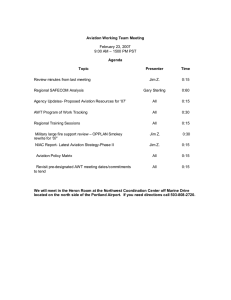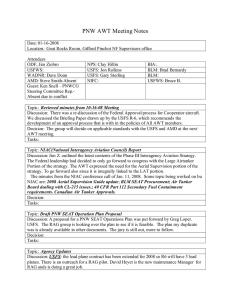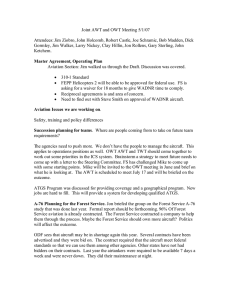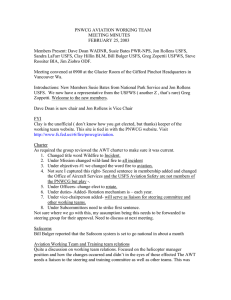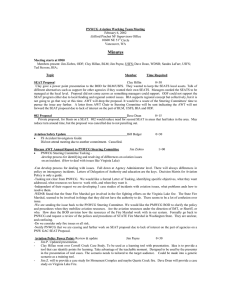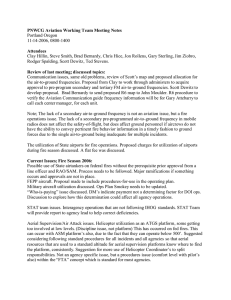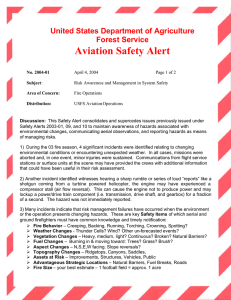PNWCG AVIATION WORKING TEAM MEETING MINUTES 09 October 2002
advertisement
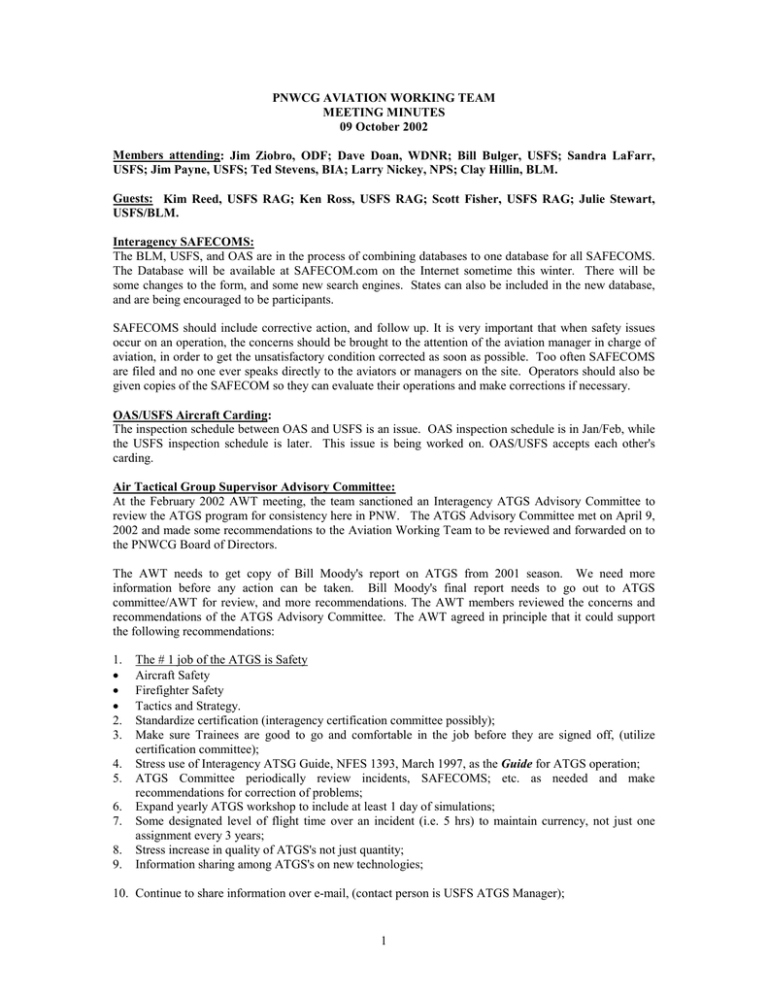
PNWCG AVIATION WORKING TEAM MEETING MINUTES 09 October 2002 Members attending: Jim Ziobro, ODF; Dave Doan, WDNR; Bill Bulger, USFS; Sandra LaFarr, USFS; Jim Payne, USFS; Ted Stevens, BIA; Larry Nickey, NPS; Clay Hillin, BLM. Guests: Kim Reed, USFS RAG; Ken Ross, USFS RAG; Scott Fisher, USFS RAG; Julie Stewart, USFS/BLM. Interagency SAFECOMS: The BLM, USFS, and OAS are in the process of combining databases to one database for all SAFECOMS. The Database will be available at SAFECOM.com on the Internet sometime this winter. There will be some changes to the form, and some new search engines. States can also be included in the new database, and are being encouraged to be participants. SAFECOMS should include corrective action, and follow up. It is very important that when safety issues occur on an operation, the concerns should be brought to the attention of the aviation manager in charge of aviation, in order to get the unsatisfactory condition corrected as soon as possible. Too often SAFECOMS are filed and no one ever speaks directly to the aviators or managers on the site. Operators should also be given copies of the SAFECOM so they can evaluate their operations and make corrections if necessary. OAS/USFS Aircraft Carding: The inspection schedule between OAS and USFS is an issue. OAS inspection schedule is in Jan/Feb, while the USFS inspection schedule is later. This issue is being worked on. OAS/USFS accepts each other's carding. Air Tactical Group Supervisor Advisory Committee: At the February 2002 AWT meeting, the team sanctioned an Interagency ATGS Advisory Committee to review the ATGS program for consistency here in PNW. The ATGS Advisory Committee met on April 9, 2002 and made some recommendations to the Aviation Working Team to be reviewed and forwarded on to the PNWCG Board of Directors. The AWT needs to get copy of Bill Moody's report on ATGS from 2001 season. We need more information before any action can be taken. Bill Moody's final report needs to go out to ATGS committee/AWT for review, and more recommendations. The AWT members reviewed the concerns and recommendations of the ATGS Advisory Committee. The AWT agreed in principle that it could support the following recommendations: 1. · · · 2. 3. 4. 5. 6. 7. 8. 9. The # 1 job of the ATGS is Safety Aircraft Safety Firefighter Safety Tactics and Strategy. Standardize certification (interagency certification committee possibly); Make sure Trainees are good to go and comfortable in the job before they are signed off, (utilize certification committee); Stress use of Interagency ATSG Guide, NFES 1393, March 1997, as the Guide for ATGS operation; ATGS Committee periodically review incidents, SAFECOMS; etc. as needed and make recommendations for correction of problems; Expand yearly ATGS workshop to include at least 1 day of simulations; Some designated level of flight time over an incident (i.e. 5 hrs) to maintain currency, not just one assignment every 3 years; Stress increase in quality of ATGS's not just quantity; Information sharing among ATGS's on new technologies; 10. Continue to share information over e-mail, (contact person is USFS ATGS Manager); 1 11. Stay with 310-1 standards emphasizing using Interagency ATGS Guide; 12. Purchase Interagency ATGS's Guides and get them out to all ATGS's; The AWT felt there are some issues that need to be resolved before the recommendation can be forwarded to the Board for action. Some of the issues are: · Who is responsible for oversight and administration of the program? · What is the oversight role? · Clarification of issues; The AWT felt that if we want quality leadership, the program will an Interagency Program Leader, and could use one full time. The BLM has a permanent Air Attack Position open at Vale. This position has been hard to fill due to the grade level. This position could be a good fit with the program leader. It would give the position interagency responsibilities and boost the pay grade to make it more attractive. Before any further action is taken on these issues the AWT felt the recommendations should be sent back to the ATGS Committee for the following actions: · Convene a meeting of the committee this fall; · Choose a member to fill the position of committee chair; · Pick out 3 items from the recommendations that could be implemented in 2003 fire season; · Do the staff work and develop a proposal to put forward to the Board of Directors. · Report back to the Aviation Working Team prior to the spring meeting March 03. Redmond ATGS Platform: Some changes need to be made in the USFS/BLM ATGS training platform in Redmond. The program is not working as it is presently situated. Air Operations Qualifications in 310-1: There was a concern expressed that some of the qualifications for Air Operations Positions in 310-1 may not be accurate. Clay will check on this and validate the concern. If the concerns are valid the AWT could make recommendations to NWCG with needed 310-1 changes. Helicopter Manager Training: Kim Reed and Ken Ross from the Regional Air Group presented a training proposal to the AWT. The RAG proposed an interagency sub-committee to sanction aviation training courses for validation. The objective is to get all of the interagency cooperators on the same standardized aviation training relative to helicopters The AWT referred the proposal to the PNWCG Training Working Team for discussion and acceptance. SEATS: Type 1 Air Tankers may be reduced in the future. There are questions relating to how we will deal with fires if we have an Air Tanker short fall. Two SEATS working in tandem can be very effective for initial attack. Some proposals are to look at present Air Tanker bases and replace the shortfall with 2 SEATS. The SEAT proposal that was proposed by the AWT in 2002 was not accepted and can be considered dead at this point. The question was asked should we revive the SEAT proposal again and forward it to the PNWCG. The consensus of the team was that the proposal has merit but the timing is bad, especially in the face of the present budget shortfalls. STAT Team Issues: During the 2002 fore season the PNWCG Aviation Working Team put together several STAT Teams to serve the multitude of concurrent fires. One of the issues that came up was the ability to attach trainees to the STAT Teams. The concern is that there would be too many people on the team, which would tend to overwhelm the aviation operation. Future aviation managers need to see how these teams work. They can be brought onto the team as an observer, or secretary, and limit one per STAT Team. This should be spelled out in the Letter of Delegation to the STAT Team from the AWT. The AWT also emphasized that a STAT team is a support team not an inspection team. The AWT should continue to resist the pressure to joint the STAT Team with the FAST Team. The Chair of the AWT should be the one to manage the STAT 2 team as was done this season. A notification to all line officers should be made before the team gets to the site, and a copy of the Letter of Delegation should be e-mailed to each line officer as well. Interagency Aviation Policy Matrix: Some minor changes need to be made to the Interagency Aviation Policy Matrix. Most of the changes were grammatical in nature. This will be updated and put on the AWT web page. WDNR near mid-air collision with Canadian Bird Dog: WDNR had multiple fires and brought in Canadian air tankers with bird dogs. While operating in a smoky environment, with poor communications, a helicopter and bird Dog came very close to a mid air collision. Dave Doan gave the AWT a review of the incident. Communications was the big issue along with differences in operational policies between WDNR and Canadians. We need to try to meet with the representative from Canada before next year to try to include them in our system. It should be stressed that COMMUNICATIONS is the key to a safe operation. We need to learn each other's operations procedures so we can mitigate any unsafe situation that may arise. Dave was going to try to set something up next spring. The package Dave put together will be forwarded to the ATGS Advisory Committee for review. This incident illustrates the need to adopt the Fire Traffic Area concept that was developed in California and Region 5. ODF has already adopted the FTA in their procedure manual with modified trigger points. This concept needs to be brought to Board of Directors for adoption for next season. We need to involve the ATGS Advisory Committee and present a proposal to he BOD this spring. If adopted this needs to be mailed and brought to the attention to all our aircraft operators. FY-2003 AWT officers: January 1.2003 will be the start of a new year and new officers for the Aviation Working Team. Steve Rossiter, BIA will become the new Chairman, and Dave Doan, WDNR will become the Vice-Chairman. Officers for 2004 will be WDNR as Chair, and USFS as Vice-Chair. Jim Payne, USFS Region 6 Aviation Officer is moving to a new position in Boise Idaho. Good luck Jim! Jim's last day at the Region will be 18 October02. Airspace: Julie Stewart gave an airspace update. During this season Julie brought in 25 Air Space Coordinators for 50 assignments, to help out with de-conflicting the air space for the multitude of fires. The Airspace guide is soon to be completed and some chapters will start appearing on the airspace web page. Juliewill help Jim Ziobro with preparing the Fire Traffic Area proposal to the BOD. Agency Updates: WDNR: In the process of acquiring cobra helicopters through the FEPP program, to replace they're aging UH-1's. 8 Helicopters will be acquired. They will be training to upgrade their pilots and mechanics. BLM: There is a letter out form Steve Jenkins on the new radios. The IAMS course has been absorbed and is now ACE. There will be an interagency conference in Phoenix AZ., in Oct 23-24 2002. January 2124 there will be a Train the Trainer course put on somewhere in the PNW. The site is to be determined. NPS: Susey Bates is the new Aviation Manager. Larry Nickey will remain as the NPS representative to the AWT for now. 3 USFS: Region 6 will be getting a new Aviation Officer. There was a change in leadership at the national level. Bill Bulger will be gone for 7 weeks and Terry Behan will be filling in an R-6 Aviation Safety Manager. BIA: BIA will take over as chair of the AWT for 2003. BIA will be offering some helicopter training before next season but nothing is firm yet. Ted Stevens BIA email is down so all communications should be done by phone or land mail. ODF: ODF will not longer be the chair of the AWT after December 31, 2002. ODF had a very busy fire season. There was one helicopter accident in southern Oregon due to an engine failure. The agency report will be out soon. The NTSB is still investigating the cause of the engine failure. ODF Fire Aviation Procedures Manual will be updated for next season. It seemed to work out very well this year. ODF will be putting on S-372 Helicopter Manager Training in December 2002. PNWCG Aviation Working Team presented three Aviation Safety Awards to three pilots flying for ODF for exceptional flying ability during Two were for the pilots involved in the aircraft accident and extrication id injured persons, and another for engine failure in eastern Oregon. NEXT AWT MEETING WILL BE JANUARY 17, 2002. Meeting is to be held at the Gifford-Pinchot NF Supervisors Office, Vancouver Washington. 4
